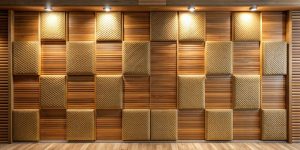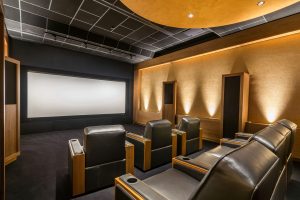Why Is “Your Brain On Sound”? – Part 1
This is really about “why is your brain on acoustics?”, though most people don’t care why our ear-brain hearing system is affected by sound in rooms. But for anyone interested in how we perceive sound and – more to the point here – why that perception should dictate how we design recording studios, stereo-listening rooms, and home theaters– it’s worth investigating. Our hearing system is one of the most important and evolved survival tools humans possess, and is highly influenced by the physical spaces in which we work and live. So let’s investigate why room acoustics change our perceptions.
We’re already aware, at a subconscious level, that our hearing is affected by the environment around us. It’s not simply that the sound of our own voice changes in different rooms– it’s that our well-being is tied to the cues given by our hearing system to our “fight-or-flight” system of staying alive.
When I was 16 years old, I wondered why my drums sounded like a different kit in different rooms; when I was 27 I wondered why the recordings I engineered sounded different in different rooms; and when I was 39 I wondered why sound changed radically as I moved around my own recording studio rooms. Curiosity is a huge part of any technology-based profession (or should be, certainly), and in trying to make the recording studio sound better, I wondered (and learned) more and more about how acoustics work.
And now, working in the acoustics business, I found there’s a lot of old and new research into “our brain on sound”, and why it remains an important part of healthy living, whether for survival, entertainment, or sleeping well. Mainly what I found out was this: it’s all about timing.
Comedians have always claimed “it’s all in the timing”, and that’s true for sound as well, due to the way our brain processes sounds around us. It hinges on the link between timing and directionality: if you’re a Paleolithic caveman hunting for lunch and a twig snaps somewhere nearby, you’d better know – instantly! – where the sound came from, so you can escape in the opposite direction. If not, YOU might be lunch (saber-tooth tigers and all…).
Our brain compares the timing difference between ears to determine which ear sensed the twig snap first and by how much, to calculate the sound’s direction. This timing differential is critical, and it gets processed in about a thousandth of a second – one millisecond, which is literally unthinkably fast. Then our brain determines how big and close the sound is in the next thirty milliseconds. All this takes place before our “thinking” brain is even aware of the sound, and a perceived threat immediately triggers a physical response. We then processes the identity of the sound in the next thirty milliseconds: Tiger? Kitty-cat? Dangerous? Really cute? What our ears and brain determine about any sound is processed nearly instantaneously, giving our body a chance to react without thinking – a system vastly predating humans. Sound processing is hardwired as an evolutionary tool, and our hearing is always turned on – we have no “earlids”.
It is short, sharp sounds called “transients” – like twig snaps – that are primarily what our brain listens for, because it can process these short sound impulses to determine directionality much faster than slower sounds. So when there’s a snap or a click in the night, we wake up quickly, ready to run. We generally ignore sounds that are steady over time – “sleep machines” feature slow wave-and-wind sounds that can cover up transients. Audible impulse sounds are the enemy of deep sleep (and deep thought), and you can blame our evolution for that, though without our hearing sensitivity, we’d have probably gone extinct by now.
What does all this have to do with acoustical products? Tune in next week for “Why Is “Your Brain On Sound”? – Part 2”

















One comment on “Why Is “Your Brain On Sound”? – Part 1”
Pingback:
Why Is “Your Brain On Sound”? – Part 2 | Acoustic Geometry